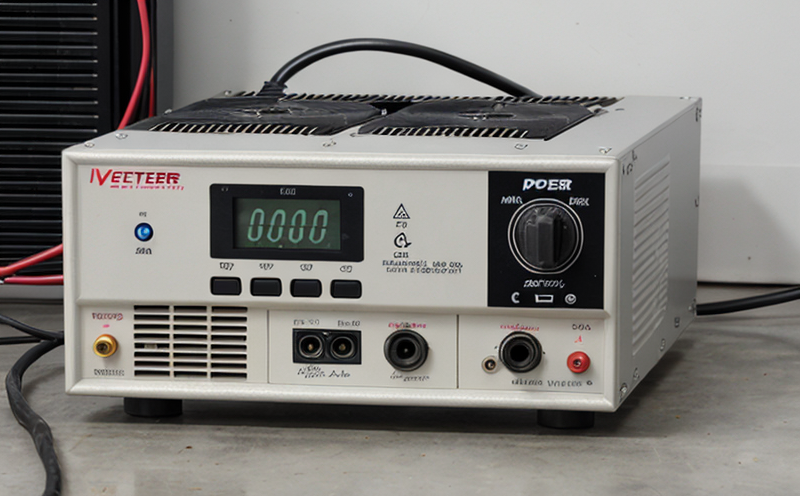ASTM E3010 Harmonic Distortion Testing of Inverters
The ASTM E3010 standard provides a comprehensive framework for evaluating harmonic distortion in inverters, which are critical components in renewable energy systems. Harmonic distortion refers to the presence of unwanted frequencies that can disrupt power quality and efficiency within electrical networks. This testing is vital for ensuring compliance with international standards such as IEEE 519-2014 and IEC 61000-3-2, which aim to minimize the adverse effects of harmonic currents on power systems.
The testing process involves several key steps: specimen preparation, instrumentation setup, data collection, and interpretation. Specimens are typically inverters that have been manufactured in accordance with specific technical requirements. The test setup includes a comprehensive range of equipment such as current transformers, voltage sensors, and spectrum analyzers to capture the harmonic content accurately.
The acceptance criteria for ASTM E3010 testing are stringent and are designed to ensure that the tested inverters meet or exceed specified limits for total harmonic distortion (THD). The standard specifies upper limits for the THD of various harmonics, with particular emphasis on the 5th and 7th harmonics. Compliance with these limits is crucial for maintaining grid stability and minimizing interference with other connected devices.
The significance of this testing cannot be overstated, especially in renewable energy systems where inverters are responsible for converting direct current (DC) from solar panels or wind turbines into alternating current (AC). By adhering to ASTM E3010 guidelines, manufacturers can ensure that their products perform reliably and safely within the electrical grid.
A table summarizing key parameters is provided below:
| Parameter | Description |
|---|---|
| Total Harmonic Distortion (THD) | The ratio of the RMS value of the total harmonic content to the fundamental frequency component. |
| Harmonic Limits | Specific limits for 5th and 7th harmonics as per IEEE 519-2014 and IEC 61000-3-2. |
The testing process is rigorous and involves multiple stages. Initially, the inverter is connected to a controlled power supply that simulates real-world conditions. The current and voltage are measured using high-precision instruments. The data collected is then analyzed to determine the THD levels at various points within the frequency spectrum.
Once the testing is complete, detailed reports are generated, outlining the results of each harmonic component. These reports serve as a critical tool for quality managers, compliance officers, and R&D engineers in making informed decisions about product design and performance improvements.
- Ensures compliance with international standards.
- Enhances power quality within electrical networks.
- Minimizes interference between connected devices.
In conclusion, ASTM E3010 Harmonic Distortion Testing of Inverters is an essential service for manufacturers and suppliers in the renewable energy sector. By adhering to this standard, companies can ensure that their products meet stringent quality and performance criteria, thereby enhancing reliability and safety within the electrical grid.
Benefits
The benefits of ASTM E3010 Harmonic Distortion Testing are manifold. Firstly, it ensures compliance with international standards, which is crucial for market access in many countries. Secondly, it enhances power quality by reducing harmonic distortion, thereby improving the overall efficiency and stability of electrical networks.
- Ensures compliance with IEEE 519-2014 and IEC 61000-3-2.
- Improves reliability and safety within electrical grids.
- Enhances the performance of connected devices by minimizing interference.
The testing process also provides valuable insights into product design, allowing manufacturers to identify areas for improvement. This can lead to enhanced efficiency, reduced maintenance costs, and increased customer satisfaction. Furthermore, compliance with these standards can open up new markets and opportunities for growth.
Industry Applications
The ASTM E3010 Harmonic Distortion Testing is widely applicable across various sectors within the energy industry, including solar power systems, wind farms, and hybrid renewable energy projects. This testing ensures that inverters function optimally under a wide range of conditions, thereby maximizing the efficiency and reliability of these systems.
- Solar Photovoltaic (PV) Systems
- Wind Turbine Inverters
- Hybrid Energy Systems
In solar PV systems, inverters play a critical role in converting the DC power generated by photovoltaic panels into AC power suitable for use in homes and businesses. Harmonic distortion testing ensures that these inverters operate efficiently, thereby maximizing energy output.
Wind turbine inverters are similarly crucial components of wind farms, where they convert variable-frequency AC from the turbine to a constant frequency suitable for transmission over long distances. Testing these inverters helps to ensure consistent power quality and system reliability.
In hybrid systems that combine solar and wind technologies, inverters must be capable of handling a wide range of inputs. Harmonic distortion testing ensures that these inverters can operate effectively under diverse conditions, thereby enhancing the overall performance of the system.
Use Cases and Application Examples
The following use cases highlight the practical applications of ASTM E3010 Harmonic Distortion Testing in real-world scenarios:
| Use Case | Description |
|---|---|
| Solar Farm Inverter Optimization | Testing inverters used in large solar farms to ensure optimal power output and compliance with standards. |
| Wind Turbine Maintenance | Periodic testing of wind turbine inverters to identify potential issues and maintain system reliability. |
| Hybrid Renewable Energy System Upgrades | Testing new inverters for hybrid systems to ensure they meet performance and compliance criteria. |
In addition to these use cases, the testing can also be applied during product development to identify potential issues early in the design process. This proactive approach ensures that products are robust and reliable from the outset.
- Testing inverters for solar farms to ensure optimal power output.
- Periodic testing of wind turbine inverters to maintain system reliability.
- Testing new inverters for hybrid systems during upgrades.
The real-world examples serve as a testament to the importance of this testing in ensuring reliable and efficient energy systems. By adhering to ASTM E3010 standards, companies can ensure that their products perform consistently under various conditions.





